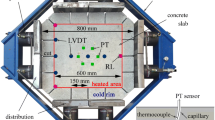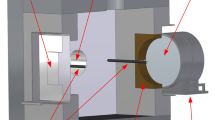Abstract
A mathematical model of hygro-thermo-mechanical phenomena in heated concrete, treated as multiphase porous material is briefly presented. Some modifications necessary to analyse high–temperature performance of a concrete containing the PP-fibres have been introduced, experimentally validated and applied for analysis of performance of a concrete tunnel lining during a 10-MW fire and the ISO standard fire. Three methods for protecting concrete structures against excessive degradation in fire conditions have been numerically analysed by means of the computer model. The analysed protection methods are based either upon application on a structure surface of a reflective layer, or covering it with a protective layer made of a very porous concrete or an addition of the PP fibres to the concrete mix. Efficiency of these methods has been numerically analysed in thermal conditions corresponding to the ISO-834 standard fire. The results obtained show that even relatively simple methods, like application a protective layer or increasing the surface reflectance, can retard to some extent concrete degradation during a fire.
Similar content being viewed by others
References
Baroghel-Bouny V, Mainguy M, Lassabatere T, Coussy O (1999) Characterization and identification of equilibrium and transfer moisture properties for ordinary and high-performance cementitious materials. Cement Concrete Res 29:1225-1238
Bathe KJ (1996) Finite element procedures. Prentice-Hall Inc, Upper Saddle River
Bary B (1996) Etude de couplage hydraulique – mècanique dans le béton endommagé, Laboratoire de Mécanique et Technologie, C.N.R.S. de Cachan, Université de Paris 6, Publication no. 11, Cachan
Bazant ZP, Kaplan MF (1996) Concrete at high temperature. Longman Harlow
Bianco M, Bilardi G, Pesavento F, Pucci G, Schrefler BA (2003) A frontal solver tuned for fully-coupled non-linear hygro-thermo-mechanical problems. Int J Numer Methods Eng 57(13):1801–1818
Gawin D (2000) Modelling of coupled hygro-thermal phenomena in building materials and building components (in Polish) Habilitation Thesis. Scientific Bulletin of Lodz Technical University, 853, Lodz: Editions of Lodz Technical University
Gawin D, Witek A (2004) Effect of surface reflection properties of concrete tunnel on its degradation during fire (in Polish). In: Proceedings of the National Conference on ‘Contemporary problems of fire safety in civil and environmental engineering’, Poland, Koszalin-Mielno, pp 126–135
Gawin D, Majorana CE, Schrefler BA (1999) Numerical analysis of hygro-thermic behaviour and damage of concrete at high temperature. Mech Cohesive Frict Materials 4:37–74
Gawin D, Pesavento F, Schrefler BA (2002a) Modelling of hygro-thermal behaviour and damage of concrete at temperature above the critical point of water. Int J Numer Anal Methods Geomech 26(6):537–562
Gawin D, Pesavento F, Schrefler BA (2002b) Simulation of damage – permeability coupling in hygro-thermo-mechanical analysis of concrete at high temperature. Commun Numer Methods Eng 18:113–119
Gawin D, Pesavento F, Schrefler BA (2003) Modelling of thermo-chemical and mechanical damage of concrete at high temperature. Comput Methods Appl Mech Eng 192:1731–1771
Gawin D, Pesavento F, Schrefler BA (2004) Modelling of deformations of high strength concrete at elevated temperatures. Concrete Sci Eng Materials Struct 37(268):218–236
Gawin D, Pesavento F, Schrefler BA (2006) Towards in prediction of the thermal spalling risk through a multi-phase porous media model of concrete. Comput Methods Appl Mech Eng (in print)
Gawin D, Alonso C, Andrade C, Majorana CE, Pesavento F (2005a) Effect of damage on permeability and hygro-thermal behaviour of HPCs at elevated temperatures, part 1: experimental results. Comput Concrete 2(3):189–202
Gawin D, Majorana CE, Pesavento F, Schrefler BA (2005b) Effect of damage on permeability and hygro-thermal behaviour of HPCs at elevated temperatures, part 2: numerical analysis. Comput Concrete 2(3):203–214
Gray WG, Schrefler BA (2001) Thermodynamic approach to effective stress in partially saturated porous media. Eur J of Mech A Solids 20:521–538
Kalifa P, Chene G, Galle C (2001) High-temperature behaviour of HPC with polypropylene fibers. From spalling to microstructure. Cement Concrete Res 31:1487–1499
Kalifa P, Menneteau FD, Quenard D (2000) Spalling and pore pressure in HPC at high temperatures. Cement Concrete Res 30: 1915–1927
Khoury GA (1995) Strain components of nuclear-reactor-type concretes during first heating cycle. Nuclear Eng Des 156:313–321
Khoury GA (eds) (1999) HITECO – Understanding and industrial application of high performance concrete in high temperature environment. Final report of the Brite Euram III BRPR European project no. CT95–0065. Imperial College, London
Lewis RW, Schrefler BA (1998) The finite element method in the static and dynamic deformation and consolidation of porous media. 2nd edn. Wiley, Chichester
Mazars J (1986) Description of the behaviour of composite concretes under complex loadings through continuum damage mechanics. In: Lamb JP (ed) Proceedings of 10th US National Congress of Applied Mechanics, ASME
Mazars J, Pijaudier-Cabot J (1989) Continuum damage theory – application to concrete. J Eng Mech ASCE 115(2):345–365
Pesavento F (2000) Non-linear modelling of concrete as multiphase porous material in high temperature conditions. PhD Thesis, University of Padova
Picandet V, Khelidj A, Bastian G (2001) Effect of axial compressive damage on gas permeability of ordinary and high-performance concrete. Cement Concrete Res 31:1525–1532
Phan LT (1996) Fire performance of high-strength concrete: a report of the state-of-the-art. In: Research report NISTIR 5934, National Institute of Standards and Technology, Gaitherburg
Phan LT, Carino NJ, Duthinh D, Garboczi E (eds) (1997) Proceedings of international workshop on fire performance of high-strength concrete, Gaitherburg (MD), USA. NIST special publication 919, National Institute of Standards and Technology, Gaitherburg
Schrefler BA (2002) Mechanics and thermodynamics of saturated–unsaturated porous materials and quantitative solutions. Appl Mech Rev 55(4):351–388
Schrefler BA, Gawin D (1996) The effective stress principle: incremental or finite form?. Int J Numer Anal Methods Geomech 20(11):785–815
Schrefler BA, Brunello P, Gawin D, Majorana CE, Pesavento F (2002) Concrete at high temperature with application to tunnel fire. Comput Mech 29:43–51
Thelandersson S (1987) Modeling of combined thermal and mechanical action on concrete. J Eng Mech ASCE 113(6):893–906
UPTUN (2005) 5 FP project ‘UPTUN’, test report no. 875–05–004 “Real scale tunnel fire test. Virgolo tunnel, Bolzano, Italy, University of Natural Resources and Applied Life Sciences, Vienna
Wang X, Gawin D, Schrefler BA (1996) A parallel algorithm for thermo- hydro-mechanical analysis of deforming porous media. Comput Mech 19(2):94–104
Witek A, Gawin D (2005) Effect of the PP-fibres on degradation and moisture phenomena in HPC concrete at high temperature (in Polish). Inżynieria i Budownictwo 61(2):92–94
Zienkiewicz OC, Taylor RL (2000) The finite element method, the basis. Butterworth-Heinemann, Oxford
Author information
Authors and Affiliations
Corresponding author
Rights and permissions
About this article
Cite this article
Witek, A., Gawin, D., Pesavento, F. et al. Finite element analysis of various methods for protection of concrete structures against spalling during fire. Comput Mech 39, 271–292 (2007). https://doi.org/10.1007/s00466-005-0024-7
Received:
Accepted:
Published:
Issue Date:
DOI: https://doi.org/10.1007/s00466-005-0024-7




